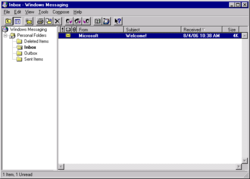- Windows Messaging
-
Windows Messaging 
Windows Messaging running on Windows NT 4.0.Developer(s) Microsoft Stable release 4.00.835.1374 (version 5.0) / October 14, 1996 Operating system Microsoft Windows Type E-mail client License Proprietary EULA Website Exchange update for Windows 95 Windows Messaging, initially called Microsoft Exchange, is an e-mail client that was included with Windows 95 (beginning with OSR2), 98 and Windows NT 4.0.
In Windows 98, it is not installed by default, but available as a separate program in the setup CD.
Contents
History
Microsoft Exchange gained wider usage with the release of Windows 95, as this was the only e-mail client that came bundled with it. Exchange was included throughout later releases of Windows up until the initial release of Windows 98, which by then also included Outlook Express 4.0.
- In 1996, Microsoft Exchange was renamed Windows Messaging, because of Microsoft's release of another Exchange product, which was meant for servers.
- Windows Messaging had two branches of successors:
- In software bundled with Windows itself, these were Internet Mail and News in Windows 95 (and bundled with Internet Explorer 3), which was succeeded by Outlook Express 4.0 in Windows 98 (bundled with Internet Explorer 4.0 in Windows 95) and throughout newer Windows systems. These did not use the .pst file type.
- Microsoft Outlook became the professional-grade and more direct successor of MS Exchange Client, which still uses the .pst file type.
Microsoft Fax
Microsoft Fax, also called Microsoft at Work Fax (AWF), is the fax component to provide Send-and-Receive Fax capability; sent and received faxes were stored in the same .pst file as other messages, first attempt of unified messaging by Microsoft; also the ability to act as fax server[1], which is not available in later versions of Windows until Windows Vista
Criticisms
- Because Microsoft Outlook used the same basic Windows Messaging profile, account and e-mail settings (MAPI), MS Exchange users not familiar with it could have been led into thinking that Outlook created a double profile and that it made copies of all their mail while they were just checking to see what the new MS Outlook (ver. 97) looked like. This way some MS Exchange users could have unknowingly deleted all their e-mail that they perceived to be 'double', as MS Outlook did not have any front-end feature to notify users that it was actually using the same MS Exchange or Windows Messaging account.
- The original version lacks support of Internet mail (SMTP and POP3 support). They are only available with the other-purchased Microsoft Plus! pack.
- No support for International characters. Some e-mail that was sent with a non-ASCII or non-7/8-bit character set, was shown in the form of text attachments, which had to be saved and then read in a web browser, with the browser's text encoding set for a specified code page.
- HTML e-mail was shown in such a way that the message contained an *.ATT or *.htm attachment, which had to be saved and then viewed in a browser, as MS Exchange did not have support for HTML-formatted messages.
- In a similar fashion, e-mail that did not use traditional message formatting, was shown the same way: actual message content was delivered in the form of text attachments with the *.ATT extension, which could be opened through Notepad. These files were in turn saved in the active Temp directory and some sensitive e-mail could therefore have been made available for other users to see.
See also
External links
Windows Internet Explorer Versions MainOtherOverview History · Removal · Easter eggs · Box model · Add-ins · Browser Helper Object (BHO) · Extensions · ShellsTechnologies MSXML · RSS Platform · Smart tags · JScript · DHTML (HTA · HTML Components) · Vector Markup Language · MHTML · HTML+TIME · XHR/XDomainRequest · ActiveX · WPAD · Temporary Internet Files · Index.dat · favicon.ico · Web Slice · AcceleratorSoftware & Engines Administration Kit · Developer Tools · Integrated Windows Authentication · Tasman · Trident (Chakra)Implementations Outlook Express · Internet Mail and News · Comic Chat/Chat 2.0 · NetMeeting · NetShow · ActiveMovie · DirectX Media · Windows Address Book · Windows Desktop Update · Active Desktop · Active Channel · Channel Definition Format (.cdf) · Microsoft Java Virtual Machine (MSJVM) · Server Gated Cryptography (SGC) · MSN Explorer · MSN for Mac OS X · SpyglassEvents People Web browsers (timeline · comparison · usage · list) References
Categories:- Internet Explorer add-ons
- Windows email clients
- Discontinued Microsoft software
- Windows 95
- Windows NT
- Windows 98
- Discontinued Windows components
- Fax
- Fax software
Wikimedia Foundation. 2010.
